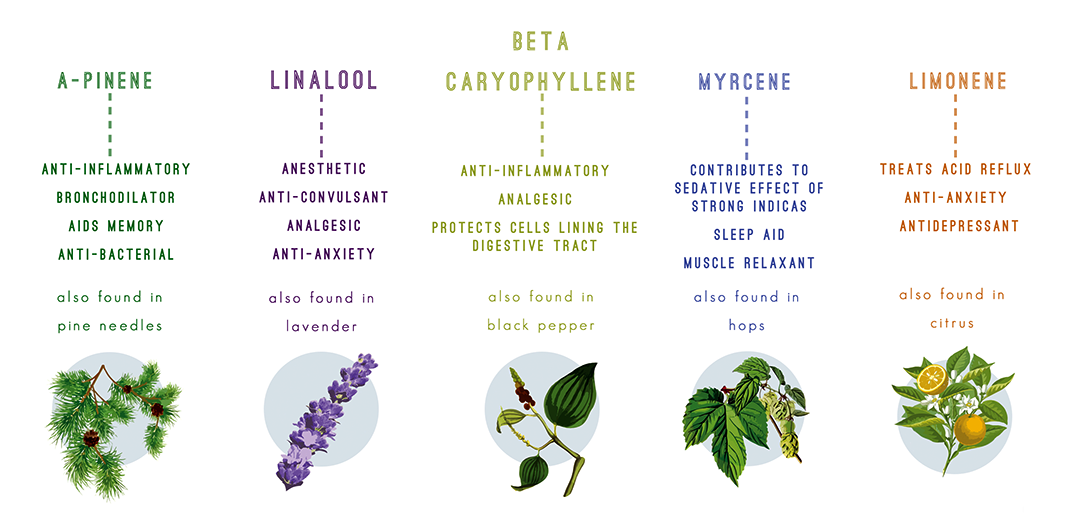DECARBING (The Science of Cannabis: Extraction Methods & More)
Decarboxylation, commonly referred to as decarbing, turns THCA into THC. You’ve probably heard of activated THC and non-activated THCA, but what does that actually mean? THC gets you high and THCA does not. THCA is a non-psychoactive molecule found in cannabis. THC is psychoactive.
Besides psychotropic effects, these molecules also differ by size and acidity. THCA needs heat to turn into THC, is larger and more acidic (the ‘A’ stands for carboxylic acid group in chemistry). THC is smaller and does not contain the acidic ‘A’ group. Researchers at University Medical Centre Freiburg in Germany have observed a slower rate of absorption for acidic molecules, which could be why THC is found in higher concentrations in the body than THCA.
Furthermore, you need heat to decarb THCA. These molecules are not the same and should never be added together for “total THC” content.

THE DIFFERENCE IN THESE TWO MOLECULES IS THE PRESENCE/ABSENCE OF THE COOH (CARBOXYLIC ACID) GROUP
WINTERIZING (The Science of Cannabis: Extraction Methods & More)
This process creates a product that is further purified by removing the fats and waxes from the plant. Winterizing entails dissolving the extract (non-polar) in a polar liquid (usually ethanol), freezing the mixture at sub-zero temps, then removing the waxes through a low-micron filter.


IN A CANNABIS EXTRACTION, THE FATS WILL SIT ON TOP OF THE ORGANIC LAYER AND CAN THEN BE REMOVED.
Winterizing makes the concentrate more stable because the lipids (fats) are removed. Removing the fats prevents the extract from softening and reduces the tendency to butter. If the fats are not removed, the product is referred to as wax.
DISTILLATION (The Science of Cannabis: Extraction Methods & More)
Short path distillation is currently the most common technique. With short path distillation, the oil is exposed to heat and deep vacuum, which are used to separate various cannabinoids and terpenes from concentrate.
Heat is introduced via the mantle to evaporate the cannabinoids and terpenes. Unlike liquid, vapors will rise, which allows the separation to happen within the condenser. Cannabinoids travel through the short path and end up re-condensing into a liquid in the last step. Only the cannabinoids get isolated from the rest of the “crude” concentrate.
Distilled products do not need to be winterized because the waxes do not vaporize and stay in the crude concentrate. Distillation typically yields a higher concentration of cannabinoids than other methods.
LIVE RESIN (The Science of Cannabis: Extraction Methods & More)
Typically, cannabis is dead (cured) and dried before getting processed into extract. Cryogenic freezing sets this method apart. Freezing the plant shortly after harvest is the key here. It gives the extract a flavor that closely resembles a living cannabis plant. A living plant is cut, frozen with freezantas (like liquid nitrogen) and the final product is made within hours. A Closed-Loop Hydrocarbon Extraction Machine is generally used to make live resin.
One downfall to this method is price. Because the cost of production is high, the cost for consumers is going to be higher than average. More terpenes stay in tact in this process which also contributes to higher market prices for live resin.

A LIVE PLANT IS CUT THEN CRYOGENICALLY FROZEN HOURS AFTER TO ACHIEVE LIVE RESIN. THE END PRODUCT IS PICTURED
HASH/HONEY OIL (BHO + PHO) (The Science of Cannabis: Extraction Methods & More)
Hash oil is made by using a Closed Loop Extraction. It is a system of stainless steel vessels that “wash” cannabis material with liquid butane or propane solvent.
The process starts with filling a column with broken-down cannabis and “washing” it with liquid hydrocarbons (butane or propane). Hydrocarbon just means the compound is made-up solely of Carbon and Hydrogen molecules. Butane and Propane are hydrocarbon solvents. After being collected, the concentrate/solvent mixture is put inside a vacuum oven where excess solvent is removed from the mixture at a much lower temperature than if it were at regular atmospheric pressure.
Propane is very similar to BHO. The main difference between these two hydrocarbons is pressure that is released at boiling point. Butane has a higher boiling point (30°F) because it is one carbon longer than propane, with a boiling point of -44°F. It is worth noting that BHO and PHO are referred to as shatter when waxes and fats are not in the end product.
State laws set legal parts per million (ppm) standards for these solvents. As of January 2017, these limits were raised. Now, instead of hundreds of ppm’s of solvent being allowed in extracts it is thousands. Rightfully so, this raise in ppm allowance got backlash from cannabis industry. Mike Van Dyke of the Colorado Department of Public Health and Environment stated that the “numbers came from the international harmonized guidelines for residual solvents in pharmaceuticals.”
As someone with a background in biology and chemistry, I do not agree with the raise in parts per million (ppm) allowance for solvents. These guidelines apply to pharmaceuticals, ingested by mouth and should not apply to cannabis, commonly consumed by smoking or vaporizing. Butane expands 200:1 when combusted, which could lead to dangerous amounts of butane for the human body. To keep consumers safe, there should be more than 5 years of clinical trials before just passing a law without seeing the effects. Colorado passed medical cannabis legalization in 2010. 7 years is a small amount of time for clinical trials, as most last a minimum of 8 years.
BUDDER (The Science of Cannabis: Extraction Methods & More)
Budder does not have a specific process, as the final product can be obtained in many different ways. When shatter is unstable, it will turn into a budder. If a cannabis extract is made with highly resinous plant material, the waxes will cause the shatter to turn into budder.
ROSIN/BUBBLE HASH (The Science of Cannabis: Extraction Methods & More)
Rosin and Bubble Hash are end products of solventless extractions. One reason solventless methods are more desirable is because only heat and pressure are used and there is no chance of having any residual solvent in the final product. Water is also used in solventless methods.
The materials you need for bubble hash are simple: cannabis, ice, water and filters. This method claims to be solventless- one reason it can be called solventless still is because water (a very weak solvent) isn’t harmful and ppm detections for water aren’t necessary. Making rosin can be even simpler than making bubble hash.
For rosin, the only materials needed are cannabis, heat and pressure. For small-scale production, people often use a hair straightener, parchment paper, and gloves for safety to press rosin. For those that have access to a lab, an industrial sanitary press can be used in place of a hair straightener. A press utilizes higher pressure and therefore a lower temperature, which keeps more terpene content in the extract (remember: more heat = more degradation). If an extract is ‘pressed’ there is a good chance it is rosin, but you can also press bubble hash and dry sift hash to get a product that more closely resembles shatter.
CO2 OIL (The Science of Cannabis: Extraction Methods & More)
A Thermodynamics Research Laboratory at the University of Illinois at Chicago stated that organic solvents currently on the market can have negative long-term effects. Why does this matter? Because organic solvents have a wide array of uses including decaffeinating coffee and making pharmaceutical drugs. The less hazardous chemicals we use in these processes, the less exposure humans and animals will have. One solution researchers pose is to use supercritical fluids (SCFs) instead of common, commercial solvents.
SCFs are compounds that behave as both a gas and a liquid, so they diffuse more easily than solvents. Carbon Dioxide (CO2) is one SCF that has shown promise as a replacement to other solvents. Because diffusion happens more efficiently with CO2 and other supercritical fluids, the final product will have more potency. CO2 oil allows for more high-driving compounds (like terpenes) to be present in the final product because of the lower volatility of the compound.
Patients treating seizure disorders and cancer tend to be drawn to this product because of the potency and purity. For these patients, CO2 oil is more desirable than a distillate because of the terpene content.
To ingest this product, you first want to know if it is decarbed/activated or not. If it is a decarbed product, it is ready to ingest and you can either dab it or consume it by mouth. Consuming it with a fatty substance like coconut oil or butter will make the oil have higher bioavailability, meaning it can be absorbed into the body more easily. If the oil has not been activated (THCA instead of THC) simply eating it won’t get you high, but your body still gets the health benefits of a non-psychoactive cannabinoid, similar to ingesting CBD or CBN.
TERPENES (The Science of Cannabis: Extraction Methods & More)
Essential oils and terpenes are the same thing, the words are interchangeable.
Research is still being done to learn more about how terpenes drive your high. Some would even argue that a cannabis plant’s terpene profile is more responsible for your high than THC content. With that being said, when shopping for cannabis, looking only at THC content can be a bad representation of the high. One theory I personally have is that when a plant has lower THC, it is because the THC is being compensated for something else like terpenes. Adding terpene content back into other extracts creates a more diverse, well-rounded high when compared to just having the isolated THC alone. Terpenes are commonly re-introduced into distillates for the reasons above and also to “thin out” viscous distillate for cartridges and syringes.
TERPENES ARE ESSENTIAL OILS AND EXIST NOT ONLY IN CANNABIS, BUT IN ALL PLANTS.
Original article link: Green Dream Cannabis
Written by: RACHEL WELLENDORF









